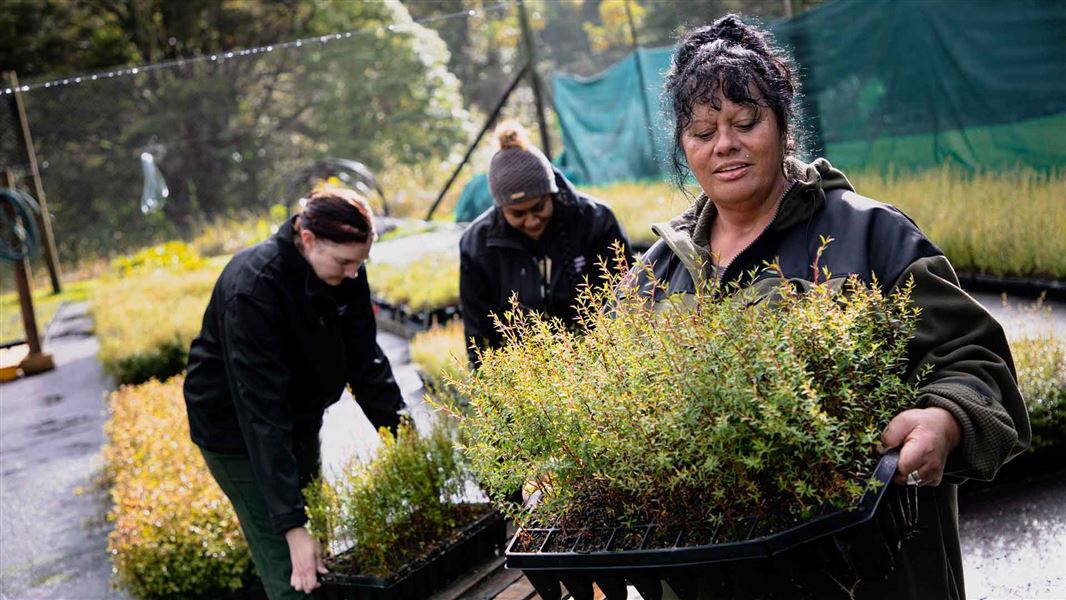Archived content: This media release was accurate on the date of publication.
Date: 11 March 2022
The project was completed by two staff employed through the Government’s Jobs for Nature programme and one volunteer.
Matt Calder, DOC’s Kauri Coast project manager for landscape predator control, says Te Toa Whenua Restoration Project, led by Te Iwi o Te Roroa, has made impressive gains over a short time since kaimahi started on the ground around 5 years ago.
“The 900 hectare restoration of former plantation pine forest is one of the most ambitious in the north – the area is inundated with pest plants and menaced by pest animals – but Te Roroa have done an outstanding job of securing funding.”
In addition to the Government’s Jobs for Nature funding, DOC is supporting Te Toa Whenua through the Ngā Awa river restoration programme by working with Te Roroa on monitoring the rivers biodiversity, researching fish movements and finding ways to improve fish passage.
Te Toa Whenua has also attracted funding from Foundation North, the Tindall Foundation, One Billion Trees and Northland Regional Council.
As well as the pest control and research, the project has another significant achievement under its belt. With support from a number of funding streams, including Ngā Awa, the project’s nursery has transformed from a small backyard operation to a large-scale nursery, providing plants to restore the Waipoua River’s riparian margins and hillsides.
Courtney Davis, Te Toa Whenua project manager, says the project’s name is a tribute to 19th century warrior, Tūohu, who was a warrior and gardener from the local area. The phrase te toa o te whenua (the warrior of the land) is from an oriori (lullaby) composed by his cousin Taoho as a testament to Tūohu’s mana as expert in land use and management of people.
“I’m proud of the intergenerational nature of the project. It’s really cool to have older people training up the younger ones and providing employment for local people.
“Our field supervisor was formerly a forester here. Now he’s restoring the area. The work is meaningful to him because he’s regenerating those areas he was involved in felling.”
Courtney says the project has plenty of challenges. “We’re ground zero for kauri dieback and myrtle rust is another threat, so biosecurity is super important for us.
“The other challenge is the abundance of weeds. Many decades of plantation pine forestry operations have left a heavy weed burden, so two people manage weeds fulltime.”
Courtney says Te Toa Whenua Restoration Project isn’t only about planting native species. “Our vision is to support sustainable land use with local people involved through different enterprises.
“The Waipoua catchment was once a ‘breadbasket’ for surrounding communities. We want the land to become a breadbasket again.
“We’ve started horticultural projects in areas where weeds are eradicated. We’re investigating food production options and one of our first plans is to set up a banana plantation near Waipoua River’s ford.
“I’m very proud of our achievements so far. It’s really been a collective effort that will restore the whenua, so it becomes a high value habitat for our indigenous species and productive for current and future generations of Te Roroa,” Courtney says.
Background information
DOC’s Ngā Awa programme has contributed $90,000 contribution over the past two years to support the establishment of Te Toa Whenua nursery, and over $250,000 over the wider Waipoua River catchment restoration project.
Jobs for Nature has contributed almost $700,000 of funding for Te Toa Whenua for six positions over the next three years, covering pest, plant and animal control, revegetation and nursery positions.
Previous DOC support for Te Toa Whenua includes $120,000 from the DOC Community Fund.
Contact
For media enquiries contact:
Email: media@doc.govt.nz
